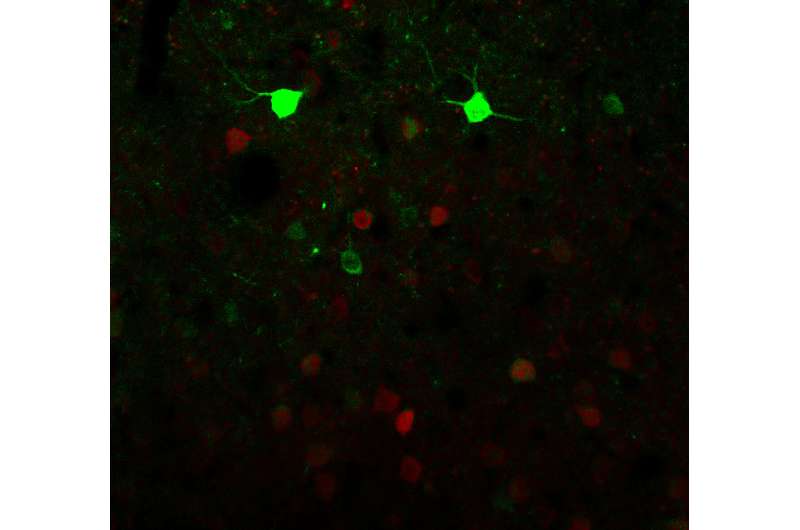Study shows that ketamine switches neuronal activity in the neocortex

Human beings can sometimes experience dissociative states, moments in which they feel disconnected from their body and the world around them. While these states have been linked to many psychiatric conditions, they can also be elicited by the intake of some legal and illegal drugs.
One of the most renowned dissociation-inducing drugs is ketamine, an anesthetic commonly used to sedate patients or reduce pain resulting from medical procedures. In recent years, ketamine has also been found to be a potentially valuable treatment for some cases of depression.
While several studies have investigated the therapeutic effects of this strong anesthetic, so far very little is known about the cellular and neuronal mechanisms behind the dissociative states it produces. A paper by a team of researchers at University of Pennsylvania, recently published in Nature Neuroscience, might shed some light on these so far elusive processes.
“As anesthesiologists, we routinely use ketamine for its reliable anesthetizing properties during surgeries,” Joseph Cichon MD Ph.D., one of the researchers who carried out the study, told Medical Xpress. “These patients often experience hallucinations, such as a sense of being outside of one’s own body, when they awaken from anesthesia. From the growing body of work by psychiatrists on ketamine, we know that lower ketamine doses have also been successfully used treat depression and other related psychiatric conditions.”
Past research suggests that patients who experience dissociative states and hallucinations after taking ketamine might be more likely to also reap its antidepressant benefits. The key objective of the recent work by Cichon and his colleagues was to better understand the neuronal activity and mechanisms underpinning ketamine-induced dissociative states.
“Another interesting thing about ketamine is that while the drug stays in the system for just about an hour after injection, the therapeutic effects on depression can last up to two weeks,” Alex Proekt MD Ph.D., another researcher involved in the study, told MedicalXpress.
“This prolonged effect is thought to be due to synaptic plasticity elicited after a single dose of ketamine through poorly understood mechanisms. It is possible that, if we understood the nature of the acute changes in neuronal activity induced by ketamine, we can begin to understand why ketamine and other drugs that are known to alter sensory perception appear to induce lasting synaptic plasticity in the brain.”
To examine the mechanisms behind ketamine-induced dissociative states, Cichon and his colleagues carried out an experiment on mice. Specifically, they administered a dose of ketamine to the mice that was predicted to produce dissociative states, and they then observed their brain activity using two-photon microscopy. This is an imaging technique that allows scientists to continuously visualize the same individual cells or neurons in a living animal’s brain over the course of several minutes or days.
“To image neuronal activity, we expressed a fluorescent calcium sensor called GCaMP6 in specific cell types,” Cichon explained. “This protein changes its fluorescent intensity depending on the calcium concentration in the neuron, which rises and falls with neuronal firing. By imaging fluctuations in the fluorescent signal in individual neurons, we could thus image how ketamine alters the neuronal activity patterns of individual neurons.”
When they analyzed the neural recordings they collected, Cichon and his colleagues found that ketamine “switched” the cortical activity in the mice’s brains. In other words, neurons that were previously very active became suppressed and neurons that were previously silent became spontaneously activated.
“During normal wakefulness, some neurons are active while others are quiescent,” Cichon explained. “Under the influence of ketamine, consistent with previous work, we find that about the same fraction of neurons are active. Yet, the surprising thing is that neurons active under ketamine are the ones that are normally silent. Conversely, the normally active neurons are suppressed by ketamine.”
Interpreting the findings gathered by this team of researchers in the context of dissociative states is not easy, due to obvious challenges in confidently determining whether the mice are experiencing these states or not. Nonetheless, Cichon and his colleagues identified two distinct cortical neuron populations, one that is active during wakefulness but suppressed by ketamine, and the other initially silent but activated under the influence of the drug.
In the future, these interesting results could pave the way for new discoveries about the neural processes that cause the brain to become disconnected from the surrounding environment while maintaining subjective experiences after the intake of ketamine. This could in turn help to understand the unique ways in which ketamine might serve as an antidepressant or anesthetic.
“We are interested in finding the common elements among different drugs that elicit a dissociative state,” Cichon added. “These drugs include psychedelic drugs as well as other anesthetic agents such as Nitrous Oxide (laughing gas). We are also extremely interested in determining the relationship between the acute changes in brain activity imposed by these drugs and their long-lasting therapeutic effects, as this may help develop new drugs to treat neuropsychiatric diseases.”
More information:
Joseph Cichon et al, Ketamine triggers a switch in excitatory neuronal activity across neocortex, Nature Neuroscience (2022). DOI: 10.1038/s41593-022-01203-5
Journal information:
Nature Neuroscience
Source: Read Full Article
